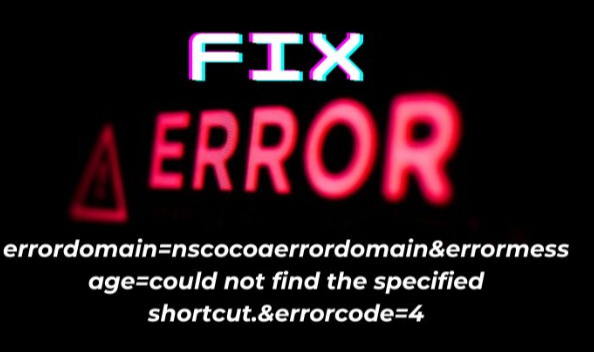
Introduction:
When navigating the digital landscape, encountering errors is inevitable. One such error, often represented by the cryptic string “errordomain=nscocoaerrordomain&errormessage=kunne ikke finde den anførte genvej.&errorcode=4,” signals an issue within the NSCocoaErrorDomain framework. In this article, we will delve into the intricacies of this error, offering insights into its meaning, potential causes, and practical solutions.
Understanding errordomain=nscocoaerrordomain&errormessage=kunne ikke finde den anførte genvej.&errorcode=4:
NSCocoa errordomain=nscocoaerrordomain&errormessage=kunne ikke finde den anførte genvej.&errorcode=4 is a domain within the Cocoa error handling system on Apple platforms. Error Code 4 within this domain specifically points to an issue related to shortcut paths, indicated by the error message “kunne ikke finde den anførte genvej” (translation: could not find the specified shortcut). Let’s explore the potential reasons behind this error and how to address them.
Incomplete Shortcut Path: A common cause of Error Code 4 is an incomplete or incorrectly specified shortcut path. Ensure that the designated shortcut is accurately referenced in your code or application.
Permissions and Access Issues: Insufficient permissions or access restrictions may hinder the system from locating the specified shortcut. Verify that the user or process has the necessary permissions to access the shortcut path.
File System Anomalies: File system inconsistencies or corruption could lead to difficulties in locating shortcuts. Running disk utility tools to check and repair the file system may help resolve this issue.
Application-Specific Problems: Some applications may encounter challenges in recognizing or accessing shortcuts. Check for updates or patches for the relevant application and ensure compatibility with the operating system.
Addressing NSCocoaErrorDomain: Error Code 4 – Step by Step: Now that we’ve identified potential causes, let’s outline a step-by-step guide to troubleshoot and resolve the NSCocoaErrorDomain: Error Code 4.
Step 1: Review Shortcut Path
Examine the designated shortcut path in your code or application settings. Confirm its accuracy and completeness.
Step 2: Check Permissions
Ensure that the user or process attempting to access the shortcut has the necessary permissions. Adjust permissions if needed.
Step 3: File System Integrity
Run disk utility tools to check and repair any file system anomalies that may be affecting shortcut recognition.
Step 4: Update Applications
Verify if the application associated with the shortcut is up-to-date. Check for updates or patches that address compatibility issues with the operating system.
Conclusion
By understanding the nuances of errordomain=nscocoaerrordomain&errormessage=kunne ikke finde den anførte genvej.&errorcode=4 and specifically tackling Error Code 4, you can navigate through shortcut-related challenges effectively. Implementing the outlined steps will not only resolve the error but also contribute to a smoother digital experience. Remember, precise coding, permissions management, and staying updated are key elements in troubleshooting and resolving such Cocoa framework errors.
FAQs
Q1: What does the NSCocoaErrorDomain: Error Code 4 signify?
A1: NSCocoaErrorDomain is a domain in the Cocoa error handling system, and Error Code 4 specifically indicates an issue related to shortcut paths. The accompanying error message “kunne ikke finde den anførte genvej” translates to “could not find the specified shortcut.”
Q2: How can I identify the shortcut path in my code or application?
A2: Review the code or application settings where the shortcut path is specified. Look for instances where the shortcut is referenced or configured, ensuring accuracy and completeness.
Q3: What should I do if permissions are the cause of the error?
A3: Check the permissions associated with the shortcut path. Ensure that the user or process attempting to access the shortcut has the required permissions. Adjust the permissions accordingly.
Q4: Are there any recommended disk utility tools to address file system anomalies?
A4: Utilize built-in disk utility tools on your operating system, such as Disk Utility on macOS or CHKDSK on Windows, to check and repair file system anomalies. Follow the prompts to address any identified issues.
Q5: How do I update applications associated with the shortcut?
A5: Check for updates or patches for the application connected to the shortcut. Visit the official website of the application or use the built-in update mechanism to ensure compatibility with the operating system.
Q6: Can NSCocoaErrorDomain: Error Code 4 affect multiple applications on my system?
A6: Yes, Error Code 4 within NSCocoaErrorDomain can potentially impact any application that relies on shortcut paths. It’s advisable to follow the troubleshooting steps outlined in the article for each affected application.
Q7: Is there a way to prevent NSCocoaErrorDomain: Error Code 4 from recurring?
A7: Regularly review and update your code, ensuring accurate references to shortcut paths. Stay informed about application updates and operating system changes that may affect shortcut recognition. Implementing these practices can reduce the likelihood of encountering Error Code 4.
